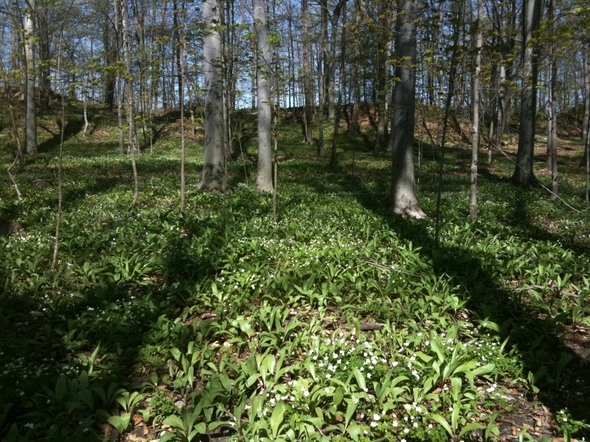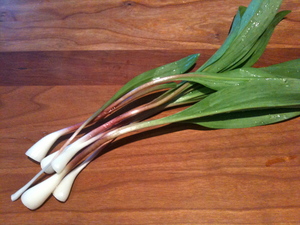Seasons eatings: Ramps are one of the first wild foods of spring

Ramps grow in the woods —they're easier to find than morels, but harvest them sustainably
Kim Bayer | Contributor
What are ramps?
Ramps are wild onions that grow especially well in places like the beautiful woods at my mom's house. They look like a short green onion, but the leaf is broader and the bulb is narrower.
They grow in clumps, or crowns, and can populate large swathes of ground. Called "ail sauvage" (wild garlic) in French, or "ail des bois" (woodland garlic), the word for ramps in the native Miami Indian language gave Chicago its name according to A Compendium of the Early History of Chicago
"The name Chicago is derived from the local Indian word chicagoua for the native garlic plant (not onion) Allium tricoccum. This garlic (in French: ail sauvage) grew in abundance on the south end of Lake Michigan on the wooded banks of the extensive river system which bore the same name, chicagoua."
What is the season for ramps?
Ramps are one of the first foods of spring, arriving in April and lasting into May.
Ramp season is also morel season and asparagus season. This trio is a good reminder of the saying that "foods that grow together, go together." How about a ramp, asparagus and morel quiche? Or pasta?
How do you find/harvest ramps?
You find ramps the way you find morels: out tromping around in the woods. But whereas morels are pretty much invisible to the untrained eye, ramps are plain to see. And it helps that they grow in huge patches. So far, I haven't seen ramps at the farmers markets around here.
So, take a trowel with you to dig them up. Recent articles have appeared documenting the over-harvesting and subsequent decline of ramps, explained in part by the fact that ramps cannot be cultivated so must be foraged. The New York Times writes:
"How to harvest ramps sustainably is a controversial subject. Seeds take 6 to 18 months to germinate, and the plants take 5 to 7 years to produce seeds. Dr. Chamberlain of the Forest Service advises foragers to avoid taking small, immature or flowering plants. He urges them to take only half of each ramp clump and replant the rest, along with the rhizome."

Ramps — ready for the saute pan
Kim Bayer | Contributor
What parts of the ramps can you use?
All parts of the plant are edible: bulb, stem and leaf. Descriptions I've read say they have the sweetness of leeks with the punch of garlic. And I'd say that's accurate.
Apparently, pickled is a popular way to both eat and preserve ramps. It's what Chef Brandon Johns of Grange Kitchen and Bar recommends. He's currently serving ramps with pork tenderloin, potato fingerlings and a fried egg.
So far I've tried ramps on the grill with steak, and sauteed with scrambled eggs, but I'm really excited about trying them sauteed in butter. And I think I'll add a few roasted hazelnuts, the way they do it at Cookshop in NYC.
Here's a recipe for sauteed ramps from Cookography
SAUTEED RAMPS
Ingredients:1 tablespoon butter
Ramps
Salt and pepper
Directions:
Remove the roots from the ramps and wash. Coarsely chop the ramps, separate the white bulb parts.
Place a non-stick saute pan over medium-high heat and melt the butter.
Once the butter has stopped bubbling, add the white bulb part of the ramps, stirring frequently.
As soon as the white portions begin to turn translucent, add the remaining parts of the ramps.
Once the green portions begin to wilt, remove the pan from the heat and salt to taste. The ramps will reduce a lot and will not require much salt.
Serve!
Kim Bayer is a freelance writer and culinary researcher. Email her at: kimbayer at gmail dot com.


Comments
Elaine F. Owsley
Tue, Jun 14, 2011 : 12:11 p.m.
I don't know about the woods, but they grow all through my perennial beds and would take over if left to their own devices. Maybe I should try cooking them.
Tom Teague
Tue, May 17, 2011 : 6:40 p.m.
It's not just a midwest phenomenon. In my Tennessee youth, I accompanied my grandfather when he campaigned at the Ramp Festival in Cosby, Tennessee. Sadly, after running 57 years and earning the title of Tennessee's longest running festival, it was cancelled this year in part due to termite damage at the Cosby Ruritan Club building. The ramp festivals in Flag Pond, TN and several other rural mountain communities throughout Appalachia are still in full swing, however, where ramps are sometimes referred to "ramsons" (ram's sons) due to their emergence under the sign of Aries, the ram.
Grace1
Tue, May 17, 2011 : 4:57 p.m.
My first time of being exposed to ramps was at Whole Foods. The color is quite pretty, with maroonish stems/stalks; a unique looking vegetable. Recipe sounds very good!